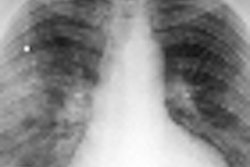(Radiology Review) Cardiac MDCT angiography for assessing coronary artery disease and coronary bypass grafts has enabled right ventricular (RV) function assessment, according to a study in the May issue of the American Journal of Roentgenology.
Dr. Cédric Plumhans and colleagues from RWTH Aachen University Hospital in Aachen, Germany, sought to compare the reliability of global RV function, which is clinically important in patients suspected of "pulmonary hypertension, cardiomyopathy, acute or chronic pulmonary embolism, cardiac insufficiency, and myocardial infarction," using contrast-enhanced ECG-gated cardiac 64-slice MDCT with 1.5-tesla cine MRI.
Plumhans and his colleagues examined 38 patients (25 men and 13 women, mean age 55 years ± 8.8) using contrast-enhanced 64-slice MDCT (Somatom Sensation Cardiac 64, Siemens Healthcare, Erlangen, Germany; 64 mm x 0.6 mm, 120 kV, 770 mAseff). On the same day, all patients underwent 1.5-tesla MRI (Gyroscan Intera, Philips Healthcare, Andover, MA; balanced fast-field echo; TR/TE, 3.3/1.6; flip angle, 60°; 50 phases) using a five-channel cardiac coil.
They found agreement in RV volumes measured with MDCT compared with MRI and good correlation for the mean ejection fraction (EF) calculated from MDCT (51%) and MRI (51.4%). Furthermore, they found excellent correlation for end-diastolic volume (EDV), end-systolic volume (ESV), stroke volume (SV), and EF, without significant statistical difference.
Nonionic contrast (Ultravist 370, Bayer HealthCare, Leverkusen, Germany) was injected into the antecubital vein through an 18-gauge venous access. A 10-mL bolus of contrast medium was injected at a flow rate of 5 mL/sec, followed by a 50-mL saline chaser injected at 5 mL/sec. The time between injection and maximum enhancement in the ascending aorta was used to calculate the time until optimal contrast opacity in the coronary arteries.
"The total volume of contrast medium used was calculated as the scanning time multiplied by the flow rate of 5 mL/sec plus an additional 8 mL, resulting in a mean total contrast volume of 75 ± 2 mL," the authors wrote.
For this study, the use of a contrast injection protocol optimized for enhancement of the coronary arteries did not restrict the evaluation of global RV function. "All MDCT and MR examinations were completed without complications, and all were of diagnostic quality," they wrote.
Compared with MRI, cardiac ECG-gated 64-slice MDCT demonstrates RV function with acceptable reliability and excellent correlation for EDV, ESV, SV, and EF measurement, they stated, even though contrast injection is optimized for visualization of the coronary arteries. Patients having coronary CT angiography will benefit from RV function assessment. However, radiation exposure and the use of iodinated contrast limit MDCT for cardiac function assessment, the authors wrote.
"Global Right Ventricular Function on 64-MDCT Compared with MRI"
Cédric Plumhans et al
Department of Diagnostic Radiology, RWTH Aachen University Hospital, Pauwelsstraβe 30, D 52057 Aachen, Germany
AJR 2008 (May); 190:1358-1361
By Radiology Review
July 4, 2008
Copyright © 2008 AuntMinnie.com




















